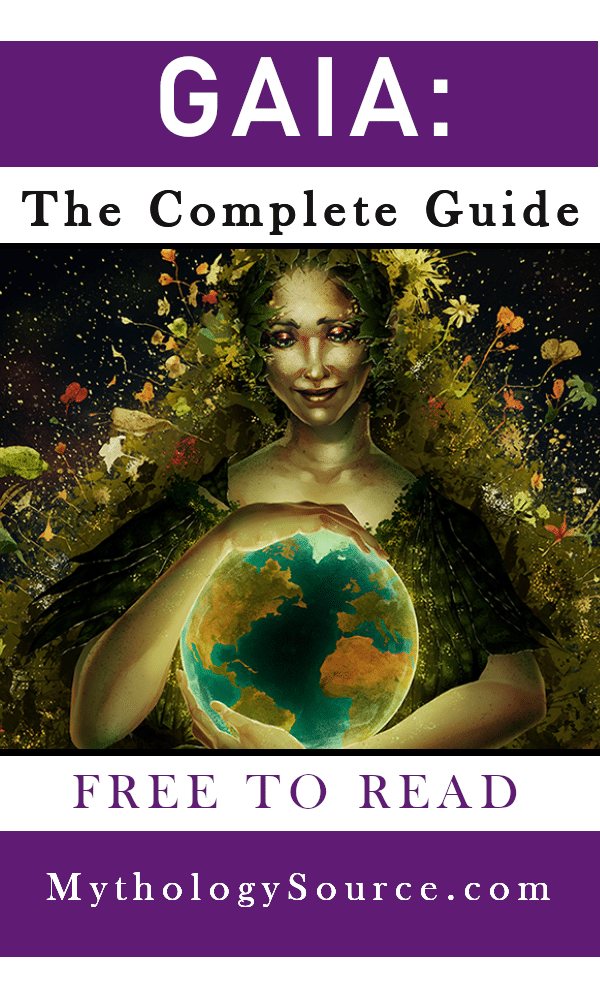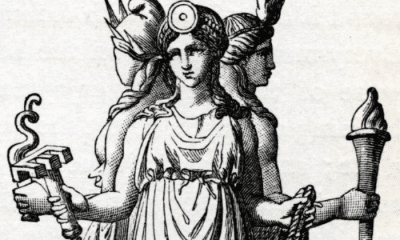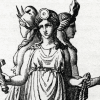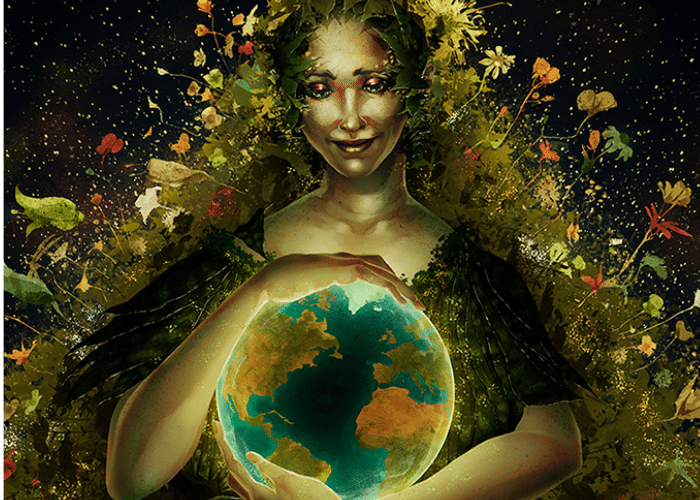
Greek
Gaia: The Greek Mother Earth
Gaia: The Greek Mother Earth
If you think Mother Earth is a modern idea of peace and love, wait until you hear how the Greeks viewed Gaia, the mother of all life!
When you hear about “Mother Earth,” you might think of modern environmentalism or New Age spirituality. But the idea of Earth as our mother is as old as civilisation itself.
The Greeks called her Gaia, a name that came for the word for the earth itself (ge). Among the oldest beings in the cosmos, she was the beginning of all life.
Gaia was the mother of all creation in the mythology of Greece and, like any mother, she could be fiercely protective of her children.
Known as Terra to the Romans and with equivalents around the globe, Gaia was an elemental power of fertility, creation, and maternal love.
Gaia was a loving mother who shared everything she had with her children, but she could also unleash terror on anyone who threatened them.
Read on to learn all about Gaia, her children, and her place in the worldwide tradition of mother goddesses!
Gaia at the Beginning
In the minds of the Greeks, the universe did not begin with the gods of Olympus. Earlier, primordial forces laid the foundations for the world as it was known to them.
In the beginning, Khaos was the only thing that existed. This confused mass of elements was nothing but vast space, existing without form, time, or company.
From Khaos, the first elements formed.
The Greeks understood the elements not as the chemical bases we know of today, but of the basic building blocks of the physical world. To them, the elements included things like air, light, and darkness.
Gaia was the elemental earth.
Many mythologies say that Gaia, along with the other primordial deities, emerged spontaneously from Khaos. Others say that Aether (the upper atmosphere) and Hemera (the day) were her creators.
Gaia in art was shown as a matronly woman rising from the earth or reclining into it. She was never separated entirely from her elemental form.
Often she was surrounded by the plants that grew from her soils. Sometimes they were depicted as literal children.
A fertile goddess by her nature, Gaia soon began to have children. All the physical elements and the deities who controlled them in the beginning were descended from her.
The first children of Gaia included Uranus (the sky), Ourea (mountains), and Pontus (the sea).
In the cosmology of early Greece, these beings existed together with the other prime elemental deities. Gaia was represented as a flat disk with the sea encircling her and the mountains resting on her breast.
Uranus took the form of a dome, arching above her. Tartarus, the dark underworld, was a dome that stretched beneath the disk of Gaia.
Together with the other elements to emerge from Khaos, these forces were the primordial deities of Greek mythology. Gaia and her offspring would be the ancestors of all subsequent powers and lifeforms.
Gaia and Pontus together created the powers of the sea. The secrets and dangers of the deep were their children.
Gaia’s most famous union, however, was with Uranus. The earth and sky together formed the greatest of the first gods.
Gaia’s first twelve children with Uranus were the Titans. These would become the first generation of gods, and the mothers and fathers of the Greek pantheon.
The Protective Mother
Gaia had given birth to the first and greatest of her children, but she didn’t stop at the act of creation. When her children were mistreated or threatened, she would do anything to protect them.
She would even destroy her other offspring if necessary.
The first being to fall afoul of Gaia’s maternal instinct was her own offspring and the father of many of her children, Uranus.
While the Titans were the greatest of Gaia and Uranus’s children, they were not the only ones to be born to the pair. Gaia had also given birth to the immortal Giants.
The three Cyclopes were enormous one-eyed humanoids. Their greatest skill was in metalworking and they powered their forges with lightening.
The three Hecatonchieres, or Hundred-Handers, were even more unusual. With a hundred hands and fifty heads each, they moulded and blew the stormclouds.
Unlike the Titans, these children were monsters. Their father hated them and imprisoned them deep within Gaia’s body.
Gaia could not locate her six hidden children as she could not see within herself. But she felt immense pain as they clawed and scratched within her.
To the mother goddess, it did not matter if her children were beautiful or hideous. Their suffering was more than she could bear.
Gaia was furious at Uranus for treating her children so poorly. She begged the twelve Titans to help her get revenge on him.
Only Chronos, the youngest of the Titans and the personification of time, was willing to challenge Uranus. Gaia gave him a sickle of adamantine to use against his father.
Chronos laid in wait until Uranus came to see his wife. With a swipe of the sickle, Chronos castrated his father, stealing his power.
Chronos took his father’s place as ruler of the universe. Uranos and Gaia, the heavens and the earth, would be separated forever.
Gaia’s imprisoned children were not freed when their brother took power, however. Chronos proved to be just as tyrannical as Uranus and never freed the Cyclopes and Hecatonchieres.
He became obsessed with his own power and how to keep it. He went so far as to swallow his own children at birth, believing one of them would someday overthrow his rule.
This prediction came true when Zeus grew up to challenge his father. Hidden by his mother, Rhea, at birth, he freed his five siblings from their father’s stomach and began a war against Chronus and the other Titans.
They were joined by a few of the younger generation, the children and grandchildren of the original twelve offspring of Gaia.
Once again, Gaia took sides against one of her children. Still angry that six of her beloved offspring remained imprisoned, she aided Zeus in his rebellion.
Gaia asked her grandson to free the monsters that had been hidden within her. When he did, they joined him and helped to win the Titanomachy, the war against the Titans.
Zeus received one of his greatest gifts from these children of Gaia. The Cyclopes presented him with the thunderbolts that would become his chief weapon and a symbol of his power.
There were other gifts as well. Hades got a helmet with the power to make the wearer invisible, while Posiedon received a trident capable of causing earthquakes.
Zeus and his followers won the war with the help of these gifts. Chronos and the Titans were defeated and lost their hold on power.
The Hecatonchieres were sent to Tartarus to guard the defeated Titans who were jailed there. The Cyclopes, freed, featured in many later myths.
This was not the outcome Gaia had wanted, though. Six of her children had been freed, but at the cost of imprisoning even more.
As Zeus and his comrades established their new seat of power at Mount Olympus, Gaia turned against them next.
Uranus had not fathered all her children. With Tartarus she had borne a hundred more Giants.
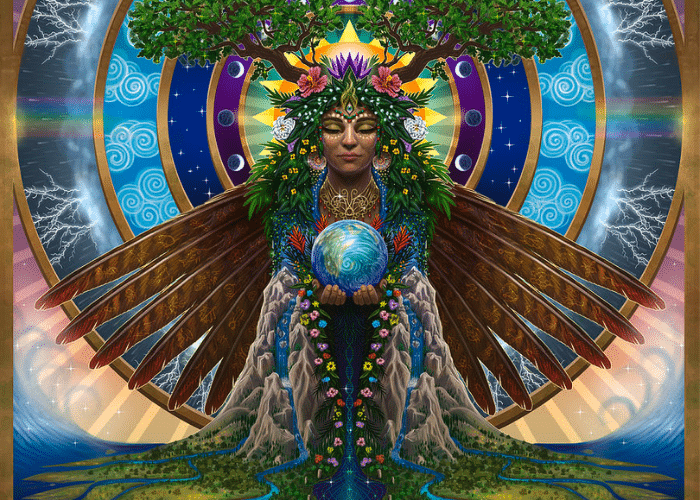
Hoping to secure freedom for all her children, Gaia once more incited her offspring to fight. This time, she sent the Giants to storm Olympus.
The resulting war was called the Gigantomachy.
Gaia had received a prophetic vision that said that the Giants would prevail if they could find a plant that would protect them from harm at the hands of the Olympians.
Zeus, however, got word of this as well. He ordered Helios, the god of the sun, and Selene, the goddess of the moon, to stop shining.
In the dark, the Giants could not find the magical plant that would protect them. They went to battle against the might of the Olympians without Gaia’s aid.
Zeus and his peers were again victorious, with each of the major gods winning a great victory in single battle. Several Giants were killed, and the rest fled throughout the world.
So many Giants were buried within Gaia that it was said that earthquakes and volcanic eruptions, relatively common occurrences around the Mediterranean, were the result of the great creatures moving in their underground tombs.
Gaia grieved for her lost children, both those who had perished and those who remained in prison. The Olympians and the race of Giants would largely remain at odds through the ages and it would be many eons before the Titans were freed.
The Other Children of Gaia
While the children of Gaia and Uranus are her most famous offspring, Gaia was given credit for the births of many other deities as well.
Many of these gods did not fit easily into the Greek pantheon. Dating from a period before the adoption of the Olympic deities or coming from foreign lands, they did not have a place in the hierarchical family tree of Greek mythology.
Among these were the so-called rustic gods. These minor gods were associated not with the heights of Greek culture, but with rural villages and agrarian life.
Outside of the capital cities and away from the great temples, these rustic gods were often holdovers from more archaic beliefs. Small villages with little outside contact were more likely to hold onto the spirits and daemons of their ancestors even after they accepted the great gods of the pantheon.
Their worship was often very highly localized as well. Rustic gods could be specific to a single mountain, lake, or valley.
Hesiod, for example, said that the Meliae nymphs were born from Gaia when the blood of Uranus fell upon her. These nymphs of bees and honey nursed the infant Zeus with their sweet nectar and the ash trees they made their hives in were used to create the Bronze Race of men.
The Curetes, the giant guardians of baby Zeus, were born in the same way.
Aristaeus, the rustic god of bee-keeping, cheese-making, hunting, and olive growing was also said by some to have been born directly from Gaia when Uranus was dismembered.
He is probably an example of a country god who, once venerated for control over all agriculture and food production, had his role minimized when the archaic Greeks introduced the Olympic pantheon.
By Pontus, the primordial sea god, Gaia was the mother of a multitude of sea gods and beasts.
Their son Nereus is more commonly remembered as the Old Man of the Sea. Representing the unknown depths of the ocean, he was a god of mystery and prophesy.
Keto represented the dangers of the deep, especially the monsters of the sea. In addition to sea beasts and dragons these included sharks and whales.
Her brother and husband was Phorcys. Together they created the monsters that represented the more specific dangers faced by sailors, such as Ladon, the serpent of swift currents and Scylla, the gigantic crab.
Many of the daemones were also born from Gaia. Not to be confused with later ideas of demons, these spirits were the personifications of emotions, abstract ideas, and specific virtues.
Some of these abstractions were well-known and often referenced, such as the Erinyes (Furies).
Others, like Pheme (Rumor) or Horcus (Oath) were more often used as poetic devices than the subject of daily worship.
Altogether there were dozens of daemones representing almost every conceivable aspect of the human condition, morality, and society.
Mankind itself could be said to have come from Gaia. In some myths the first men emerged from her fully-formed, while in others the Titan Prometheus sculpted them out of clay.
Many said that the first race of men, born in the Golden Age before strife and suffering were unleashed upon the world, were actually Giants. Over time, they decreased in stature and strength until they became the modern race of man.
Like the other Giants, these were the children of Gaia.
When Deucalion and Pyrrha survived the great flood, they were told that they could repopulate the world if they threw their mother’s bones over their shoulders. They correctly interpreted this to mean rocks, the “bones” of Gaia.
The stones they threw were transformed into men and women that could restore humanity’s numbers.
In a similar tale, the warriors of Sparta were born from dragon teeth that were sown into the earth.
Ovid wrote that after the flood that Zeus sent to destroy mankind:
All other forms of life Tellus (the Earth) [Gaia] brought forth, in diverse species, of her own accord, when the sun’s radiance warmed the pristine moisture and slime and oozy marshlands swelled with heat, and in that pregnant soil the seeds of things, nourished as in a mother’s womb, gained life and grew and gradually assumed a shape … Thus when the earth, deep-coated with the slime of the late deluge, glowed again beneath the warm caresses of the shining sun, she brought forth countless species, some restored in ancient forms, some fashioned weird and new.
-Ovid, Metamorphoses 1. 416 (trans. Melville)
Hymns to Gaia called out to her as a universal mother who cared for and protected her children.
The food and water she produced to feed mankind were likened to a mother nursing her child. She carried her children just as a human mother carries a young child.
And, like any mother, when her children suffered or faces threats she would pull them into her embrace.
The Goddess of Transformation
Gaia’s protective nature did not end with the children she had directly given birth to. She appears again and again in Greek mythology as a protector of those in need, especially women.
The most common way in which she protected them was through transformation. She magically turned humans and nymphs into plants.
This was another form of birth for the mother goddess.
These stories existed to explain the origins of the most beautiful flora in the Greek world. The transformation of a beautiful woman into a tree or flower that reflected her essence explained the graceful forms and sweet smells of some of Greece’s most beloved plants.
In other cases, people were changed through strong emotion. Grief and heartache, especially, incited pity from Gaia and she transformed people to spare them from their suffering.
The people Gaia transformed included:
- Daphne – The river nymphe was fleeing from the advances of Apollo when Gaia changed her into a laurel tree. The laurel became on of Apollo’s most well-loved symbols afterwards.
- Syceus – This Titaness was being pursued by Zeus. Gaia made her into a fig tree so she would be safe but Zeus could still enjoy her fruits.
- Ambrosia – Once the nurse of the child Dionysus, she was being chased by a wicked man. Gaia transformed her into a vine.
- Pitys – Running from Pan, she was changed into a pine tree.
- Kyparissos – When the young boy accidentally killed his pet deer with a javelin, he was overcome with grief. To spare him more suffering, he was turned into a cypress tree.
- Lotis – In this later story, Priapus attempted to rape her in her sleep. She fled and was transformed into a lotus tree to save her from shame.
- The Heliades – These sisters were so grieved by the death of their brother, Phaethon, that Gaia was moved to change them into a grove of poplar trees.
- Myrrah – In one version of the story of Adonis, his mother Myrrah fell in love with her own father. She begged the gods to spare her from a life of shame and was transformed into the myrrh tree. Adonis was born from the tree and saved by Aphrodite.
- Clytie – Abandoned by Helios, she was so distraught that she stopped eating or drinking. Gaia transformed her into the heliotrope flower, which follows the sun as it moves across the sky.
Many times in these stories of transformation, the subjects were not directly morphed into their new forms. They disappeared or were swallowed by Gaia and then were replaced by the plant she had chosen to represent them.
Other gods inherited this power from Mother Earth, although none used it as often.
Once someone under Gaia’s protection underwent such a metamorphosis they became a part of her wide array of vegetation forever. They would be the first of their kind, but in the fertile bosom of Gaia they would spread and propagate like all other plants.
Once changed, Gaia cared for these children for eternity.
Gaia the Mother of All
The Greeks saw Gaia as more than just the mother of the original immortal beings or certain types of plants. She was the lifeforce of the earth itself and, as such, the mother of all living things.
Plants and grains grew from her soil that nourished both men and animals. When these creatures died, they returned to Gaia.
In the circular pattern of life, Gaia was at the centre.
But while all living things shared this connection to Gaia, a select few were said to more intimately tied to her. In certain legends, she gave birth directly to great men and heroes.
The local legends of many Greek cities claimed that their founders and first kings had been born directly from Gaia. This claim made their original rulers closer to gods than ordinary men, and gave the entire city a divine foundation.
Athens, for example, was famously ruled by Athena’s adopted son Erechtheus. He was born, according to the popular tale, from Gaia when Hephaestos attempted to rape the virgin goddess.
Cecrops of Attica was also said to have crawled straight from Gaia. He was often portrayed as a giant man with the tail of a snake, bringing him closer to some of Gaia’s more monstrous offspring.
She was not only the mother of intelligent and human, or human-looking, creatures.
Hippolytus claimed that she had created man out of a desire to be mother to more than unreasoning plants and animals.
Everything that walked the earth or grew from it was a child of Gaia.
A hymn to Gaia from the 3rd century BC reaffirms this view of Gaia. It praises her as the endless, bottomless centre of the universe from which all living things, including all men and gods, came.
It also notes her to be a “fertile, all-destroying force.” Gaia’s power was not limited to making things grow.
No god had power over Gaia.
When the sons of Chronos took power they had divided the realms between themselves: Zeus took the sky, Poseidon took the sea, and Hades was given Tartarus. None could control or master the great Mother Earth.
The mother of all things worked together with her divine descendants, not in subjugation to them, to make the earth fruitful and full of life.
Impregnated by the rains that fell from the heavens, Gaia was tended to by Demeter to make grain grow for men and livestock. Virtually every plant and animal had a god or nymph dedicated to its personal care.
Over all the work of these goddesses, Aphrodite as the goddess of procreation made sure that Gaia’s fertile soil was kissed by the rains that would make it bloom.
The Earth Mother Archetype
The mother goddess of the earth was not unique to Greece.
Some modern historians believe that the worship of an earth mother is as old as religion itself. This archetype, they claim, is one of the most basic understandings of the way the world works.
The earth gives us food and shelters us from the elements. This nourishment and protection is fundamentally maternal in this view of comparative religion.
Whether or not it’s one of the world’s most foundational ancient beliefs, the archetype of a maternal earth is widespread.
Like many Greek deities, Gaia has a direct counterpart in Roman mythology. Terra combined an existing Latin figure with that of Greece, retaining much of the mythology related to Gaia.
Cel was the earth goddess of the Eutruscans, who predated the Roman culture in parts of Italy. She was specifically the mother of giants, like Gaia, and votives refer to her simply as “the mother.”
In Hinduism, the image of Mother Nature is one feminine aspect of the divine. She gives birth to all life from herself and nourishes them with her body.
In India’s Manipuri religion, Leimarel Sidabi is the mother goddess of the earth and nature.
In ancient Egypt, Mut was a goddess whose name meant “mother.” She gave birth to everything, either through parthenogenesis or with the solar god Amun-Ra.
The ancient Sumerian creation story has striking similarities to that of Gaia and Uranus. Ki, the earth goddess, and An, the sky, were inseparable as the parents of the gods until the birth of their youngest son drove them apart.
Several Celtic goddesses have been associated with Gaia and the mother earth archetype, although a lack of written mythology makes it difficult to accurately identify them as such.
The archetype is familiar outside of Indo-European and Semitic traditions as well.
The Incan Pachamama is worshiped to this day among indigenous Andean people. With her husband, the sun god Inti, she acted as a benevolent parent to both nature and mankind.
Several tribes in North America, including the Algonquin and the Pawnee, revered the earth as a fertile and nourishing female force.
The Pueblo people worshipped a creator goddess of the underworld. Children came from her at birth and returned at death, and through their lives she brought corn from the depths of her realm to nourish them.
The widespread oral traditions of Polynesia tell a story of the sky and the earth that is also similar to that of Gaia and Uranus. Rangi and Papa, as they are called by the Maori, were once locked in a tight embrace with their children caught in between them.
Their male sons eventually pushed them apart. Papa, like Gaia, was the mother of the first generation of gods in her pantheon.
Around the world, the fertility and nourishment provided by the earth associate it with motherhood. The earth’s opposite, the sky, is often the father of her many children.
While it will probably never be known exactly how much of Gaia’s character comes from Greece and how much can be attributed to a more ancient archetype, the figure of a mother goddess of the earth is certainly not one unique to the Mediterranean.
Belief in this ancestral form of the mother goddess has led to its widespread acceptance in neopagan and Wiccan circles.
Gaia the Primordial Goddess
As one of the first primordial beings to exist from Khaos, Gaia was a much different type of deity than the later Olympians and the demigods that served them.
The later gods were known for their very human qualities. They felt human emotion like greed, jealousy, and love.
Gaia, however, was driven only by the instinct of her innate nature. As a mother, she was protective of her children.
There was little room in her stories for the petty arguments and illicit affairs that plagued her descendents. While the gods of Olympus vied for prestige and bickered amongst themselves, Gaia’s only prerogative was the creation and protection of life.
Gaia’s protective maternal instinct could take the form of punishing those who threatened her children or bringing the innocent into herself to save them.
Like a mortal mother, Gaia was pained by the suffering of her children. Whether they felt the torment of imprisonment or the emotional pain of heartbreak, her instinct was to comfort them in whatever way she could.
She could discipline her children, and often did so, but she never wanted to see them truly suffer. Even her most monstrous and vicious offspring were precious to her and worthy of her love.
Gaia went beyond the archetype of a fertile goddess of the earth. She was a true mother goddess, a guardian as well as a creator, who from the very beginnings of the universe watched over all of creation as her children.
With thanks to WiccanMagazine.com
